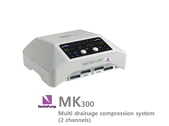What Is Peripheral Arterial Disease?
Peripheral arterial disease (P.A.D.) is a disease in which plaque (plak) builds up in the arteries that carry blood to your head, organs, and limbs. Plaque is made up of fat, cholesterol, calcium, fibrous tissue, and other substances in the blood.
When plaque builds up in the body's arteries, the condition is called atherosclerosis(ATH-er-o-skler-O-sis). Over time, plaque can harden and narrow the arteries. This limits the flow of oxygen-rich blood to your organs and other parts of your body. P.A.D. usually affects the arteries in the legs, but it also can affect the arteries that carry blood from your heart to your head, arms, kidneys, and stomach. This article focuses on P.A.D. that affects blood flow to the legs. |
Indications
|
Arterial Compression Pump Therapy
Arterial Compression Pump Systems are a gradient, sequential, pneumatic compression system that sequentially compresses both foot and calf at the highest pressure for patients suffering from diabetic foot ulcers or intermittent claudication. This therapy combines rapid inflation and graduated, sequential compression at high pressures and frequent inflation cycles. The Arterial Pump technology works to empty the veins and reduce venous resistance.
By decreasing the venous resistance, this promotes unrestricted flow across capillaries. Increasing blood flow to the extremities will help jumpstart the healing process. Additionally, rapid inflation produces sufficient shear stress within the vein to induce a biologically mediated vasodilatory effect. Both of these effects assist in augmenting arterial flow and microcirculation, thus initiating wound healing and limb salvage.
Benefits
• Increases arterial blood flow in both the popliteal artery and at the tissue level
• Evacuates venous blood from the lower limbs allowing oxygenated arterial blood to return• The comfortable, durable and reusable cuffs are ideal for home use and enhance patient compliance
• Asymmetric compression applies focused compression therapy maximizing blood velocity and total flow
By decreasing the venous resistance, this promotes unrestricted flow across capillaries. Increasing blood flow to the extremities will help jumpstart the healing process. Additionally, rapid inflation produces sufficient shear stress within the vein to induce a biologically mediated vasodilatory effect. Both of these effects assist in augmenting arterial flow and microcirculation, thus initiating wound healing and limb salvage.
Benefits
• Increases arterial blood flow in both the popliteal artery and at the tissue level
• Evacuates venous blood from the lower limbs allowing oxygenated arterial blood to return• The comfortable, durable and reusable cuffs are ideal for home use and enhance patient compliance
• Asymmetric compression applies focused compression therapy maximizing blood velocity and total flow
Contraindications
Pneumatic compression is contraindicated for the patients with infected limbs, suspected Deep vein thrombosis or arterial clots, episodes of inflammatory phlebitis or pulmonary embolism and undesirable venous and lymphatic return (as with congestive heart failure).
Pneumatic compression is contraindicated for the patients with infected limbs, suspected Deep vein thrombosis or arterial clots, episodes of inflammatory phlebitis or pulmonary embolism and undesirable venous and lymphatic return (as with congestive heart failure).







